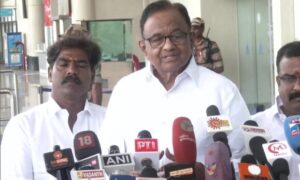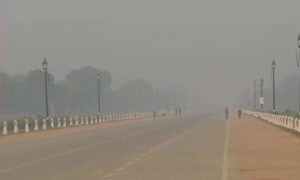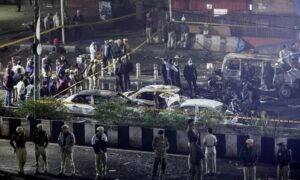
Picture : Twitter / ANI
Ramlila Maidan (ground), Delhi. In 2011, it’s where 74 year-old Gandhian, Anna Hazare held the anti corruption protests- a watershed event in the history of contemporary India. The Anna Movement, as many fondly recall it, introduced to the nation-the septuagenarian’s trusted lieutenant, Right to Information (RTI) activist, Arvind Kejriwal. Till then, not many knew the forty-something, be-spectacled, ordinarily dressed and soft spoken, Kejriwal.
On February 16, 2020, the activist-turned-politician, Kejriwal, was sworn in as Delhi’s chief minister, for the third successive time, at the same venue, which had given him a new identity. In a short span of less than nine years, the muffler man has travelled a long distance. And created history, not once but twice (in 2015 and 2020), in the politics of Delhi.
With massive victories behind him, Kejriwal’s political stock has skyrocketed. The nation is going to keenly watch his moves from now on. The Delhi CM is still young, has the administrative experience and most importantly, the appeal to win over the voters (though so far it’s been confined to Delhi). Gritty, intelligent, witty and hardworking, he is going to be a potent force in the country’s political system, in the years to come.
A man of simple tastes, Kejriwal has his trademark image: of someone who speaks the language, dresses up and offers an infectious smile, like a common man. Not being a career- politician, often helps, Kejriwal surely knows that.
In its first tryst with electoral politics in 2013, Kejriwal’s Aam Aadmi Party (AAP)- just a year after its formation- made its presence felt, strongly though. In a triangular contest, the AAP dislodged the Congress which was in power for 15 years.
With 28 seats it stood second to the BJP (31)-SAD (1) combination’s 32 in the 70 member Delhi assembly. It must be mentioned here that it happened when the Congress was also in power at the Centre. Ironically, the AAP formed the government with the support of its principal enemy –Congress- which had 8 MLA’s.
However, as expected, the AAP-Congress honeymoon didn’t last long. Failing to table the Jan Lokpal Bill in the Delhi Assembly, Kejriwal resigned and pulled the plug on his ill-fated 49-day government. He claimed it was “more important to fight corruption than to run a government.”
His decision’s difficult to fathom, though. Kejriwal’s opponents mocked at him, while the critics questioned his intent and style.
Delhi remained under the President’s rule for about a year before it went to the polls, in 2015. By then, the Narendra Modi wave had swept the country and the BJP led NDA had dethroned the UPA in the 2014 general elections. With a stunning victory the Modi era had begun. All seven Lok Sabha seats of Delhi had been won by the BJP that too with comprehensive margins. The Congress, having experienced its worst electoral performance since 1947, was sulking.
Interestingly, an emphatic BJP projected India’s first woman IPS officer, Kiran Bedi as its chief ministerial face in the 2015 Delhi polls. Well known for her courage, impeccable honesty and integrity as a top cop, Bedi, a household name in the country, had also shared the stage with Anna and Kejriwal at the Ramlila ground. The move was widely considered as a master stroke by the BJP.
However, Delhi’s voters had other ideas.
The results were unbelievable: AAP-67, BJP-3. Kejriwal had arrived in style. In the following years, he translated his ideas into action on the ground, what’s now called the Kejriwal model of Governance. In the process, he seems to have matured as a politician.
Prior to his plunge into politics, Kejriwal pursed a purely Indian middle class dream. He went to the IIT, had a brief stint in the private sector before joining Indian Revenue Service (IRS). Over a decade and some years later he quit the coveted job and became a full time activist. He received international recognition for his contribution as an activist.
A family man, Kejriwal’s former income tax commissioner wife has solidly stood by him. Along with the couple, their children- daughter who works with a leading consulting group post her IIT degree and son, also an IIT student- campaigned for the AAP in the 2020 polls.
Unlike in 2013 and 2015, when Delhi witnessed triangular contests, in 2020 it was a direct battle between the AAP and BJP. Congress was virtually out of the race. Though, pre and post poll surveys indicated an easy victory for the AAP, the BJP remained the biggest challenger. In less than a year ago, the saffron party had rode to power at the centre, again with a thumping majority in the 2019 general elections. As in 2014, in 2019 too, it had won all the Lok Sabha seats in Delhi.
Though Prime Minister Narendra Modi addressed a couple of rallies, it was home minister Amit Shah who led the BJPs campaign. He himself held forty odd rallies, while many union ministers and over 220 MPs of his party did their best to mobilize the voters to regain Delhi after 22 years. It also aggressively played the nationalism card.
On the other hand, Kejriwal kept banking on one thing: performance of his government. Ultimately performance won him and AAP the day. Though the BJP’s vote share increased, it failed to reach double digits as it bagged only 7 seats against AAP’s 63.
Many believe in the last seven years, the AAP has deviated from many of its founding principles and become like any other political party. Some of the top faces-founding members- have quit the party. In the just concluded Delhi polls, the AAP’s list of 70 candidates included some turncoats and tainted candidates. That’s, perhaps, all about politics.
[the_ad id=”22718″]


















